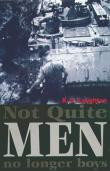AustLit
Latest Issues
AbstractHistoryArchive Description
'Kenny was barely nineteen years old, a wide-eyed Aboriginal kid from the bush, when he left Australia for a tour of duty in Vietnam. From the fleshpots of Saigon to the ‘sharp end’, clearing mines at Nu Dat, there was a lot to learn for a young man in a strange country, fighting a murky, confusing war. Not Quite Men, no longer boys is the gritty moving story of Kenny’s education in life and death – and the kinds of friendship that last a lifetime.' (Source: IAD Press website)
Notes
-
Dedication: dedicated to the sappers, NCOs and officiers of 3 troop 1 Field Squadron Nui Dat, South Vietnam, my mates. The finest bunch of men one could ever wish to serve with.
Contents
- The Tunnel Rats of Phuoc Tuyi"They sent us here to be tested in battle,", single work poetry war literature (p. 4-5)
Publication Details of Only Known VersionEarliest 2 Known Versions of
Works about this Work
-
Elite Indigenous Masculinity in Textual Representations of Aboriginal Service in the Vietnam War
2016
single work
criticism
— Appears in: Journal of Australian Studies , February vol. 40 no. 1 2016; (p. 32-44)'This article analyses three texts that feature Aboriginal soldiers or veterans of the Vietnam War as protagonists: the novel Not Quite Men, No Longer Boys (1999), the play Seems Like Yesterday (2001) and the Redfern Now television episode “The Dogs of War” (2013). In all three texts, military service in Vietnam inculcates among the protagonists sentiments constitutive of what Brendan Hokowhitu refers to as elite Indigenous masculinity—the mimicry and appropriation of white hegemonic masculinity. Constructing themselves as elite Indigenous males allows the Aboriginal soldiers/veterans to position themselves as superior to “other” Aboriginal males. Through the course of the texts, though, the protagonists come to realise that elite Indigenous masculinity is a myth because civilian (white) Australia will continue to judge them the same as other Aboriginal men. Through encounters with other Aboriginal men, the Aboriginal soldiers/veterans are able to reconceptualise their own masculinities and to accept the legitimacy of multiple Aboriginal masculinities.'
Source: Abstract.
-
Indigenous Stories Told Collectively
BlackWords : Indigenous Stories Told Collectively
2015
single work
criticism
— Appears in: The BlackWords Essays 2015; (p. 5) The BlackWords Essays 2019;In this essay Heiss discusses and explains the important role of anthologies in the creation of communities of writers and in acknowledging, consolidating and launching writing careers.
-
The Rise of Indigenous Military History
2014
single work
criticism
— Appears in: History Compass , vol. 12 no. 2 2014;'This article examines the historiography of 20th century Indigenous military service in the Anglo‐settler societies Australia, Canada, New Zealand, South Africa and the United States. It traces the emergence of ‘positive’ national narratives of Indigenous military service in the 1980s and 1990s, through to the diversification of Indigenous histories and the current shifts towards transnational and comparative analyses. The historiographic shifts have aligned with political changes within the respective nations, as well as changes in academic practice relating to Indigenous histories.' (Publication abstract)
-
An Innocent Abroad on a Tour of Duty
1999
single work
review
— Appears in: The Canberra Times , 22 May 1999; (p. 3-4)
— Review of Not Quite Men, No Longer Boys 1999 single work novel
-
An Innocent Abroad on a Tour of Duty
1999
single work
review
— Appears in: The Canberra Times , 22 May 1999; (p. 3-4)
— Review of Not Quite Men, No Longer Boys 1999 single work novel -
Indigenous Stories Told Collectively
BlackWords : Indigenous Stories Told Collectively
2015
single work
criticism
— Appears in: The BlackWords Essays 2015; (p. 5) The BlackWords Essays 2019;In this essay Heiss discusses and explains the important role of anthologies in the creation of communities of writers and in acknowledging, consolidating and launching writing careers.
-
Elite Indigenous Masculinity in Textual Representations of Aboriginal Service in the Vietnam War
2016
single work
criticism
— Appears in: Journal of Australian Studies , February vol. 40 no. 1 2016; (p. 32-44)'This article analyses three texts that feature Aboriginal soldiers or veterans of the Vietnam War as protagonists: the novel Not Quite Men, No Longer Boys (1999), the play Seems Like Yesterday (2001) and the Redfern Now television episode “The Dogs of War” (2013). In all three texts, military service in Vietnam inculcates among the protagonists sentiments constitutive of what Brendan Hokowhitu refers to as elite Indigenous masculinity—the mimicry and appropriation of white hegemonic masculinity. Constructing themselves as elite Indigenous males allows the Aboriginal soldiers/veterans to position themselves as superior to “other” Aboriginal males. Through the course of the texts, though, the protagonists come to realise that elite Indigenous masculinity is a myth because civilian (white) Australia will continue to judge them the same as other Aboriginal men. Through encounters with other Aboriginal men, the Aboriginal soldiers/veterans are able to reconceptualise their own masculinities and to accept the legitimacy of multiple Aboriginal masculinities.'
Source: Abstract.
-
The Rise of Indigenous Military History
2014
single work
criticism
— Appears in: History Compass , vol. 12 no. 2 2014;'This article examines the historiography of 20th century Indigenous military service in the Anglo‐settler societies Australia, Canada, New Zealand, South Africa and the United States. It traces the emergence of ‘positive’ national narratives of Indigenous military service in the 1980s and 1990s, through to the diversification of Indigenous histories and the current shifts towards transnational and comparative analyses. The historiographic shifts have aligned with political changes within the respective nations, as well as changes in academic practice relating to Indigenous histories.' (Publication abstract)
-
cVietnam,cSoutheast Asia, South and East Asia, Asia,
-
cAustralia,c




